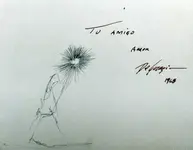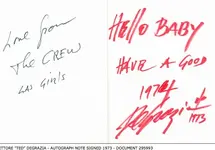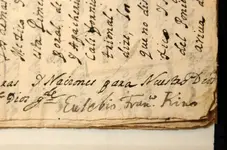To get back to this subject- I have not received a reply as of yet in regard to Fr. Segesser, but I have made inquiries to other sources. My interest in this is not just the Friar's grasp of Spanish to test the "spelling errors" hypothesis but also extends to the style of the writing used on the Stone Maps, specifically the H/P stone. As we know that stone carving is not easy, it is safe to presume that a preliminary draft was done on paper or vellum, and whoever carved the H/P stone was told to make a very exact copy of the document onto stone, this we know because it has been proven that very little on the stones is there by accident.
In making an exact copy, the carver most likely transferred the original drawer's graphological tendencies, hence the reference to graphology and related topics. If the creator of the stone was also the carver, then these tendencies would show all that much more.
I have made a number of observations, but will just list a few for sake of brevity.
1) The bottom-most of all the E's is more often than not, the longest of the three horizontal bars.
2) The Y's are more closer to an 'r' in that the left ascender is near vertical.
3) There are no diacritics.
4) The D, U, and O's are almost rectangular in feature, although this may be a function of carving in stone.
5) The upper bar of the first Z is wider than the lower. In the second Z, it is the reverse.
6) The bar of the A is more often than not, higher than the middle bar of the E.
7) Of the 5 B's, only one has a serif at the bottom, although it may be intentional- pointing at the priest, as if to relate that specific statement to the priest.
8) The letter A and R are fairly prominent, with wide, sloped legs.
9) The lines of the text slant upward more often than not.
10) Each statement starts off with a reverse indent.
The words "Peligroza" and "Santefe" warrant special attention and I will refer to them in another post.
In the meantime, with this list of graphological characteristics that we have identified, we can start to examine a variety of handwritings to see if there are any similarities to what is on the list above, starting with Fr. Kino and progressing up to Fr. Rojas, so if anyone has copies of any personal documents, letters, and otherwise written by any of the friars, please feel free to post so we can study and compare. If those documents happen to contain any Spanish phrases, we can also check for spelling competence.
The same would be true for any documents from the Peralta family. Also perhaps DeGrazia, Travis Tumlinson and some of the other suspects, if only to rule them out.
I have attached some charts illustrating how complex the science of graphology is. There is a lot that has yet to be interpreted.
View attachment 941013View attachment 941014View attachment 941015











